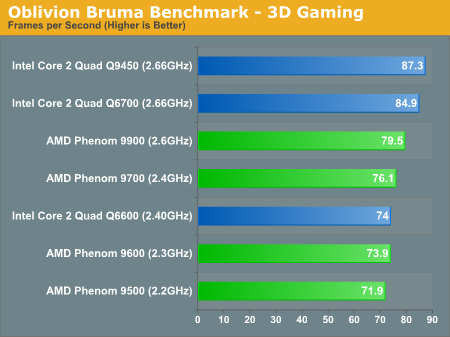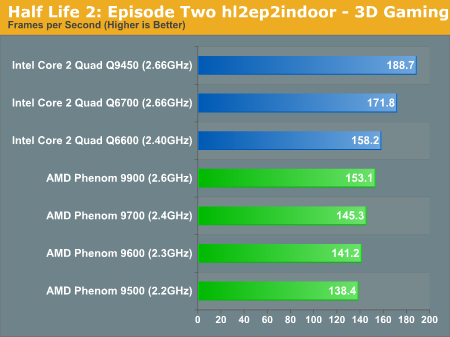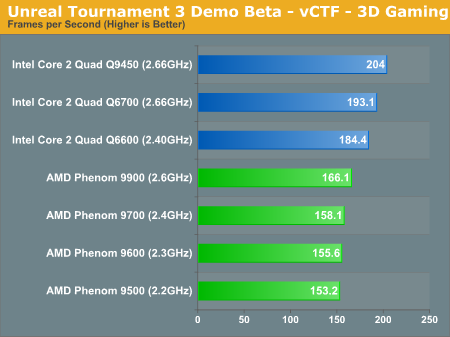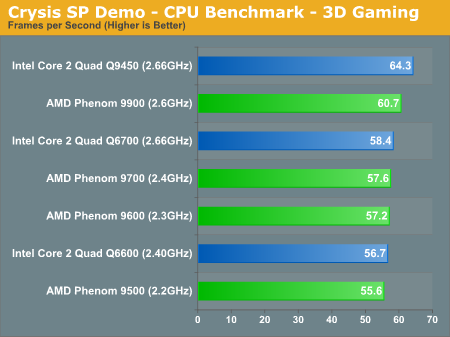AMD's Phenom Unveiled: A Somber Farewell to K8
by Anand Lal Shimpi on November 19, 2007 1:25 AM EST- Posted in
- CPUs
Gaming Performance
To highlight CPU performance differences, all of our 3D gaming benchmarks were run at 1024 x 768, so keep in mind that real world gameplay will most likely be at more GPU bound resolutions with CPU differences mattering less. That being said, this is a CPU review, so we do want to know which of these chips runs game-code the best.
It turns out that gaming performance is really a mixed bag; there are a couple of benchmarks where AMD really falls behind (e.g. Half Life 2 and Unreal Tournament 3), while in other tests AMD is actually quite competitive (Oblivion & Crysis).




While Phenom suffers greatly in video encoding and 3D rendering tests, there is hope for it as the 9700 can actually compete clock-for-clock with Core 2 in some games. If all you do is game on your machine, with the right video cards you'd be hard pressed to notice the difference between a Phenom and a Core 2 system - that being said, if you're looking at quad-core, chances are that you're doing something else with your system other than game.










124 Comments
View All Comments
opterondo - Monday, November 19, 2007 - link
C'mon guys I get blank images in this article and others, ads load just fine. IE loads just fine ..Been doing this for awhile just haven't registered till now.
crimson117 - Monday, November 19, 2007 - link
I have no problem seeing images in anandtech reviews in Opera:http://img509.imageshack.us/my.php?image=atimageso...">http://img509.imageshack.us/my.php?image=atimageso...
Regs - Monday, November 19, 2007 - link
-Motherboard support is still bad.-The promised better performance on AM2+ and couldn't deliver
-The yields are still bad
-Where the hell did "Spider" come from? What happen to the 2.4- 2.6 GHz Star? Good greif
-Quad Intel is cheaper and better. So AMD can't even offer the processor at a penetrating price into the market (which they are about 1-2 years late)
Well I'm not investing in AMD any time soon.
AmberClad - Monday, November 19, 2007 - link
I suppose the results aren't too surprisingly given AMD's lack of openness regarding Phenom. No less disappointing though.@ Anand - Kudos for taking the high road, and not accepting the trip to Tahoe on AMD's dime.
I almost had a fit though, when I read that Intel just stuffed an unreleased ES chip with a market value of >$1000 into a box and FedEx-ed it off. An armored car complete with armed guard somehow seems more appropriate :P.
michal1980 - Monday, November 19, 2007 - link
I was going to post what you did. If amd processors where better then intel, they would have sneaked a pre-view to put more wind in their sales.and you wouldn't belive what get stuffed into a fed-ex envelop.
start diamond shopping online. a few k stone = one dollar fed-ex box.
Kiijibari - Monday, November 19, 2007 - link
Overall the article is good, but the above statement is not true, there are no "inherent architectural advantages of the Core 2" there is just a CPU that is fed with Core2 optimized Code (SSE128, etc.) and another CPU that is fed with K7 optimized code in the best case (no SSE128).Thus, if you are running cinebench, you should definitely buy a Core2 CPU, but you cannot draw the conclusion that Core2 has architectural advantages. Maybe the other programs suffer also from that code problem, but it can just be proofed for cinebench:
http://www.maxon.net/pages/download/cinebenchtech_...">http://www.maxon.net/pages/download/cinebenchtech_...
It would be interesting, if you could contact Maxon and ask if they are working on K10 optimizations.
Anyways Intel would be in lead, with 45nm they could easily launch a 4 GHz part, but that is not even needed, as AMD just got 2.3 GHz. Disappointing indeed ...
cheers
Kiijibari
TA152H - Monday, November 19, 2007 - link
You haven't got a clue what you're talking about. The Core 2 and K9 (I'm not buying this is a K10, I think the benchmarks prove it's a dog. Besides, why skip a number?) are internally quite different. To say one does not have inherent advantages over the other is incredibly ill-informed. They each have advantages, it's just that Intel's tend to matter more. For example, if you are running x87 based software, the K9 is your pooch of choice. But who cares about this now? Why did AMD allocate so many resources to an obsolete instruction set (it's not even part of x86-64)? They should have killed it and saved the transistors, but they don't have the design resources. The big advantage Intel has is scheduling; it has memory disambiguation, whereas the K9 is stuck at a P6 level of scheduling loads after stores. It's a huge advantage. The whole internal architecture is different, it's very easy to understand why each would possess different performance characteristics.Software efficiency can make a difference, but your language thing is totally inappropriate. They are both being fed the same instructions for most applications, and the K9 gets raped. Now, before you whine to the moon about how it's Intel optimized, maybe you should think about how well the P8 (or P6++ if you prefer) did when it came out initially. Certainly, even you can understand it did not have optimizations, yet easily outperformed the K8 to a point where it became obvious it was obsolete. So, tell us about how optimizations for the Core 2 made it so vastly superior, OK?
The reality is, the P6 was ALWAYS better than the K7. When the K7 came out, it was slightly faster (mainly because of the memory bandwidth), but considering the power use and size, it was generally an inferior processor. The Coppermine proved to be a terrific processor and Tualatin was even better. When Intel moved it to the Pentium M line and finally increased the bandwidth, AMD could never compete in the mobile space. Face it, the K7 sucked, the K8 was dreadful, and the only reason either were successful was because the P7 was arguably the worst processor ever made and sold in any numbers. It was mind-boggling bad, and incredibly got worse with the Prescott. The K8 was the death of AMD, it didn't advance the processor design enough to compete with a good design, it was just better than a very poor one. When I saw the K8, I figured AMD was doomed, but the P7 only got worse so I ended up being wrong. Now Intel is back to the P6 derived cores, and AMD simply can not compete. It's not about optimizations, they simply don't have the design talent or resources, or the manufacturing. It's not about them not understanding something, or some weird conspiracy. It's like a mouse fighting a lion. It's OK when the lion is asleep or sick, but when it wakes up, you can't really blame the mouse for getting eaten. It never had a chance. AMD has NO CHANCE against a healthy, well-functioning Intel. They never have. They can thrive only when Intel makes egregious mistakes. Superior design, and soon the superiority of their Hafnium based manufacturing will create such a delta for AMD, they need to look for a buyer before they go belly-up.
To put it all in perspective, this new release is supposed to be AMD's leapfrog over Intel, until Intel can release the Nehalem. If they were competitive companies, that is how it would play out. Instead, it's an absolute blowout for Intel. On the release of the new AMD chips, the disparity between the two companies is the greatest it has ever been since the Pentium Pro was pitted against the 486 from AMD. AMD can improve performance though, I think it is clear the cache arrangement is very far from optimal, and can be improved significantly. The clock speeds will certainly go up quickly as well. But even with this, they will end up being slower clock normalized for most apps, and use much more power. And then, the few advantages they have go away with Nehalem. It's just going to get ugly.
AMD has returned to it's well-established role as a bottom feeding catfish. It can suck up all the waste Intel leaves it, but as a competitive company, it's over. It's been that way for a year and it's only getting worse.
Their only hope is IBM buys them. Combined they would have the ability to compete with Intel. After all, the Power 6 blows away the Core 2 and Itanium 2. AMD as an independent company makes no sense. IBM/AMD makes a lot of sense. Maybe Sun will buy the AMD corpse, but that makes less sense than IBM. It makes more sense than AMD alone though.
Is it a coincidence AMD is looking to open a fab in upstate New York? I hope not.
strikeback03 - Tuesday, November 20, 2007 - link
Didn't Anandtech report that K9 was the name of an architecture they worked on for a while but gave up on?sprockkets - Tuesday, November 20, 2007 - link
AMD had their improvements, but you are generally right, but not about IBM.Remember the days that IBM had the Cyrix processors? You know, the one with model numbers? Where did that go? They went to plucky VIA. So, IBM ditched their x86 business; what makes me think they can compete now?
Well, that is what you get if you are Intel: Have multiple teams work on processor designs, just in case one sucks.
Yet, what I always say I will say again, the vast majority of people who need a computer can have their fill with the lowly D201GLY2 board. For those who need gaming or the Aeroglass stuff, you can have a cheap AMD/nVIdia 7025 system.
As it is painfully clear now, AMD should never have done a native quad core for the desktop. Maybe for servers.
JumpingJack - Monday, November 19, 2007 - link
Yet another claiming the "software optimization theory."Architectural superiority has been demonstrated in the ability to run code faster.